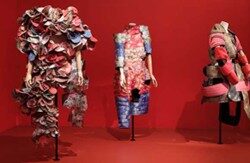
Westwood | Kawakubo: NGV hosts the works of two iconic catwalk rebels
Lucianne Tonti | The Saturday Paper | 6th December 2025
Westwood and Kawakubo are revered fashion designers. Westwood pioneered “anarchic dressing” that celebrated female sexuality. Kawakubo’s anti-fashion aesthetic offers outlandish silhouettes and is almost never sexual. Their common ground was rebellion and opposition to the “docile image of femininity”. For Kawakubo, comfort was a lesser priority than designs that made a person “aware of [one’s] existence. It just so happened that my notion [about this is] different from everybody else’s.”
